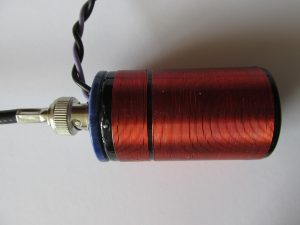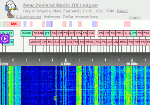HOW TO CONNECT YOUR “WORLD BAND RADIO” TO A “EWE” ANTENNA etc THROUGH INDUCTIVE COUPLING FOR MEDIUM WAVE DX:

Written by Bill Marsh (Jnr)
This article is the result of my helping Tony King interface his Tecsun PL-380 to a EWE antenna. Tony had been using an external ferrite rod antenna to inductively couple to his 380 for some time and latterly with single layer former wound coils.
As I was intending to replace my aging Sangean ATS-909 with a Tecsun PL-880 I thought his idea would be a great avenue to explore. I did not want to break the seal on my new Tecsun to carry out internal modifications.
I initially used an external ferrite rod and coil but found that placing this rod in close proximity to the internal rod in the world band radio altered the inductance of the internal rod/coil combination slightly which in turn compromised it’s performance. The conclusion was that I needed to use a single layer former wound coil.
Several types of coils i.e. single layer and honeycomb were tried but by far the best was a single layer coil. Not of my design, but a design from the 1930’s, namely a coil used in the old “Hikers One” radios, less it’s regenerative (or tickler) winding. The coil is wound on a 1 ¼ inch former (32 mm). The main winding is 110 turns and the aerial winding 40 turns. The spacing between windings is 1/16 inch or 1 mm. I don’t have my wire gauges any more to measure the wire gauge used but it is approx 32 SWG from memory. Old output transformers from old valve radios are a good source of the right size enamelled copper wire. The Engineers of yester-year suggested that the width of the main winding should be approx equal to the diameter of the coil for optimum results. This effectively determines the wire gauge. The number of turns selected was to tune 520 khz to 1720 khz using a single gang 420pf (plus) tuning capacitor. In the images shown I have paralleled two sections of a special 2 gang capacitor which has unequal sections. (Used by some manufacturers for better RF/Osc tracking). You can parallel two sections of most capacitors to allow you to tune down to 520 khz but this doubles the capacitance. This can restrict how high it will tune up to, as the HF end is critical where a small change in capacitance effects a large change in frequency. You can switch sections in or out or switch in a fixed capacitance. Ideally the best choice is a single gang with 420 pf capacitance plus.
The aerial winding is suitable for connecting to a 50 ohm preamp between the coil and the EWE antenna. I did play with the number of turns (40) on the aerial winding but it is not too critical.
The World band Radio is initially set up as per the picture. The radio or the coil (which ever is easiest) is moved sideways to peak the signal or the noise. This aligns the 2 coils and this will always be the sideways position. Next tune the variable capacitor for maximum signal or noise. Having a little calibrated dial on your tuning gang will help set it in an approximate position for any given frequency. Next is to move the radio closer or further away from the coil. Most “World Band Radios” don’t take kindly to too much signal. Too much and they display all sorts of IMD signals. There is a compromise here. If the radio is too far away from the coil the less pickup and the weaker the signal. The closer the radio is to the coil the greater the pickup and the more signal. Too close and the radio is overloaded.
I intend to make up a wooden stand that will cradle the PL-880 at the correct viewing angle. The radio will be located by means of stops so that it is always located correctly in relation to the coil. The distance between coil and radio will be able to be moved relative to each other by means of a mechanical lever or similar. The stand will house coil, variable capacitor, pre-amp, switchable attenuator and li-ion batteries to make it a completely portable setup for taking away in the caravan.
I am more than happy with this setup and signals via this method on my Tecsun PL-880 is every bit as good as on my Grundig Sat 800 connected to the same antenna.
A couple of precautions. If using another receiver connected to the same EWE antenna this arrangement might effect the other radio. Either use a splitter or two separate pre-amps. Don’t use this setup near large metal objects i.e. the bonnet of your car.
As an aside I am very pleased with my newly acquired Tecsun PL-880. SSB resolution for MW DX is excellent and a good choice of DSP filters. As an example I get a reasonably strong signal from an AM station in Auckland on 1179 khz and can quite clearly resolve Radio Marti/Rebelde (USB) on 1180 khz when these signals are present. I have not checked it on SW as these bands do not interest me. FM performance is very good as is the quality of audio.


I would welcome any feedback from those trying out this method.

The finished stand which incorporates the coil in a fixed position. Inbuilt is a 20db continuously variable attenuator (2 dB steps), a 20 dB pre-amp for use with a EWE antenna etc and a 50 ohm splitter to feed a second receiver. The outlet for the second receiver can also be connected to the SW input connector for listening to these bands on the Tecsun.
Note: All of the above was done to avoid doing internal mods to the Tecsun. DX signals on MW with this setup produces signals on a par with my Grundig Sat 800 and Drake SPR4.
Addendum:
Some confusion has arisen as to how to connect the 2 coils. Below is a diagram of the intended connections:




